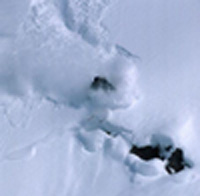



All photos © Serge Sozonoff
I have previously written about the possible occurrences of avalanches in ski resorts and tried to answer some questions to skiers, on their first ski trip, about how these forces of nature might affect them. Other than in very rare circumstances, avalanches do not cause concern to towns and villages, beginners ski slopes or even more difficult runs. Of course, in exceptional circumstances, they might become a problem and there are some examples of this happening. But, the main risk of avalanche is to skiers once they venture off the controlled or marked ski runs and venture into the territory commonly known as off piste or backcountry.
One of the most common causes of injury or death, in an avalanche situation, is the skier starting the avalanche themselves. This can be due to the skiers weight on the snow triggering a slide or the movement of the skis running through the snow and cutting the surface like a knife.
Of course, conditions vary and sometimes the snow outside the controlled or marked ski runs is safe and stable, providing no avalanche risk at all. The skill comes in being able to know when it is safe and when it is not. Ski resorts have systems in place to warn people of the dangers with various degrees of danger and symbols that clearly display what the current level is.
Click here to view the European standard system for avalanche danger.
Generally avalanches occur when there has been a heavy snowfall although this is not necessarily the case. A build up of heat can also trigger snow to slide even if the snow has been lying for many days and sometimes even weeks. A build up of wind blown snow at the top of a ridge, also known as a cornice, can also trigger an avalanche if it breaks away and starts to slide down hill, often bringing more snow with it. There are other reasons but the most common are known are as follows:
Powder Avalanches (Fresh Snow), Slab Avalanches (Layer breaking away) and Wet Snow Avalanches (warming temperatures rupturing layers).
One of the key words in avalanche knowledge is ‘Layers’. During the snowfall season there will typically be several falls of snow. Some are heavy, some are light. The temperature, wind and humidity factor can vary which creates different types of snow every time a fall occurs. This means that different layers build up, each unique in consistency, density and solidity. What this means is that often the layers do not bond together well enough and when something occurs to break that bond further, like temperature change, a skiers weight or vibration then this triggers one layer to slide off the other, creating an avalanche.
In other posts on this subject I will go into more detail about the different types of avalanche, the ways of looking at the dangers that might be told in the ‘snowpack’, and also methods of preventing being caught in an avalanche. I will also look at ways of rescue, if the worst happens and a companion is buried under the snow.
A personal friend of mine wrote a short story about one of his experiences with an avalanche in Verbier, Switzerland in 1999. I wanted to publish this story as I felt it really made you feel close to understanding the situation that is presented when encountered with this force of nature: Avalanche story
This story is written by Scott Hammond who now lives in Norway and runs White Mountain Sports, a ski school, ski shop and luxury self catering accommodation in Kvitfjell, near Lillehammer.
